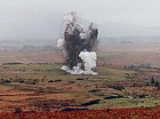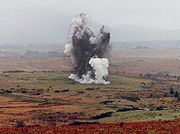
Exothermic
Encyclopedia

Thermodynamics
Thermodynamics is a physical science that studies the effects on material bodies, and on radiation in regions of space, of transfer of heat and of work done on or by the bodies or radiation...
, the term exothermic ("outside heating") describes a process or reaction that releases energy
Energy
In physics, energy is an indirectly observed quantity. It is often understood as the ability a physical system has to do work on other physical systems...
from the system, usually in the form of heat
Heat
In physics and thermodynamics, heat is energy transferred from one body, region, or thermodynamic system to another due to thermal contact or thermal radiation when the systems are at different temperatures. It is often described as one of the fundamental processes of energy transfer between...
, but also in the form of light
Light
Light or visible light is electromagnetic radiation that is visible to the human eye, and is responsible for the sense of sight. Visible light has wavelength in a range from about 380 nanometres to about 740 nm, with a frequency range of about 405 THz to 790 THz...
(e.g. a spark, flame, or explosion), electricity
Electricity
Electricity is a general term encompassing a variety of phenomena resulting from the presence and flow of electric charge. These include many easily recognizable phenomena, such as lightning, static electricity, and the flow of electrical current in an electrical wire...
(e.g. a battery), or sound
Sound
Sound is a mechanical wave that is an oscillation of pressure transmitted through a solid, liquid, or gas, composed of frequencies within the range of hearing and of a level sufficiently strong to be heard, or the sensation stimulated in organs of hearing by such vibrations.-Propagation of...
(e.g. burning hydrogen). Its etymology stems from the prefix exo (derived from the Greek word ἔξω, exō, "outside") and the Greek word thermasi (meaning "to heat"). The term exothermic was first coined by Marcellin Berthelot
Marcellin Berthelot
Marcelin Pierre Eugène Berthelot was a French chemist and politician noted for the Thomsen-Berthelot principle of thermochemistry. He synthesized many organic compounds from inorganic substances and disproved the theory of vitalism. He is considered as one of the greatest chemists of all time.He...
. The opposite of an exothermic process is an endothermic
Endothermic
In thermodynamics, the word endothermic describes a process or reaction in which the system absorbs energy from the surroundings in the form of heat. Its etymology stems from the prefix endo- and the Greek word thermasi,...
process, one that absorbs energy in the form of heat.
The concept is frequently applied in the physical sciences to chemical reactions, where chemical bond energy
Bond energy
In chemistry, bond energy is the measure of bond strength in a chemical bond. It is the heat required to break one Mole of molecules into their individual atoms. For example, the carbon-hydrogen bond energy in methane E is the enthalpy change involved with breaking up one molecule of methane into...
is converted to thermal energy
Thermal energy
Thermal energy is the part of the total internal energy of a thermodynamic system or sample of matter that results in the system's temperature....
(heat).
Overview
Exothermic refers to a transformation in which a system releases energy (heat) to the surroundings:- Q < 0
When the transformation occurs at constant pressure:
- ∆H < 0
and constant volume:
- ∆U < 0
In an adiabatic system (e.g. a system that does not give off heat to the surroundings), an exothermic process results in an increase in temperature.
In chemical reactions, the heat that is absorbed is in the form of electromagnetic energy. The loss of kinetic energy via reacting electrons causes light to be released. This light is equivalent in energy to the stabilization energy of the energy for the chemical reaction, i.e. the bond energy. This light that is released can be absorbed by other molecules in solution to give rise to molecular vibrations or rotations, which gives rise to the classical understanding of heat. In contrast, when endothermic reactions occur, energy is absorbed to place an electron in a higher energy state, such that the electron can associate with another atom to form another chemical complex. The loss of energy within solution is absorbed by the endothermic reaction and therefore is a loss of heat. This is the physical understanding of exothermic and endothermic reactions within solution.
Therefore in an exothermic reaction the energy needed for the reaction to occur is less than the total energy released.
Examples
Some examples of exothermic processes are:- Condensation of rain from water vapor
- Combustion of fuelFuelFuel is any material that stores energy that can later be extracted to perform mechanical work in a controlled manner. Most fuels used by humans undergo combustion, a redox reaction in which a combustible substance releases energy after it ignites and reacts with the oxygen in the air...
s such as woodWoodWood is a hard, fibrous tissue found in many trees. It has been used for hundreds of thousands of years for both fuel and as a construction material. It is an organic material, a natural composite of cellulose fibers embedded in a matrix of lignin which resists compression...
, coalCoalCoal is a combustible black or brownish-black sedimentary rock usually occurring in rock strata in layers or veins called coal beds or coal seams. The harder forms, such as anthracite coal, can be regarded as metamorphic rock because of later exposure to elevated temperature and pressure...
and oilOilAn oil is any substance that is liquid at ambient temperatures and does not mix with water but may mix with other oils and organic solvents. This general definition includes vegetable oils, volatile essential oils, petrochemical oils, and synthetic oils....
petroleumPetroleumPetroleum or crude oil is a naturally occurring, flammable liquid consisting of a complex mixture of hydrocarbons of various molecular weights and other liquid organic compounds, that are found in geologic formations beneath the Earth's surface. Petroleum is recovered mostly through oil drilling... - Mixing water and strong acidStrong acidA strong acid is an acid that ionizes completely in an aqueous solution by losing one proton, according to the equationFor sulfuric acid which is diprotic, the "strong acid" designation refers only to dissociation of the first protonMore precisely, the acid must be stronger in aqueous solution than...
s - Mixing alkaliAlkaliIn chemistry, an alkali is a basic, ionic salt of an alkali metal or alkaline earth metal element. Some authors also define an alkali as a base that dissolves in water. A solution of a soluble base has a pH greater than 7. The adjective alkaline is commonly used in English as a synonym for base,...
s and acidAcidAn acid is a substance which reacts with a base. Commonly, acids can be identified as tasting sour, reacting with metals such as calcium, and bases like sodium carbonate. Aqueous acids have a pH of less than 7, where an acid of lower pH is typically stronger, and turn blue litmus paper red...
s - The setting of cementCementIn the most general sense of the word, a cement is a binder, a substance that sets and hardens independently, and can bind other materials together. The word "cement" traces to the Romans, who used the term opus caementicium to describe masonry resembling modern concrete that was made from crushed...
and concreteConcreteConcrete is a composite construction material, composed of cement and other cementitious materials such as fly ash and slag cement, aggregate , water and chemical admixtures.The word concrete comes from the Latin word... - Some polymerisation reactions such as the setting of epoxy resin
- Thermite reaction
Implications for chemical reactions
Chemical exothermic reactions are generally more spontaneous than their counterparts, endothermic reactions. In a thermochemical reaction that is exothermic, the heat may be listed among the products of the reaction.See also
- CalorimetryCalorimetryCalorimetry is the science of measuring the heat of chemical reactions or physical changes. Calorimetry is performed with a calorimeter. The word calorimetry is derived from the Latin word calor, meaning heat...
- Chemical thermodynamicsChemical thermodynamicsChemical thermodynamics is the study of the interrelation of heat and work with chemical reactions or with physical changes of state within the confines of the laws of thermodynamics...
- Differential scanning calorimetryDifferential scanning calorimetryDifferential scanning calorimetry or DSC is a thermoanalytical technique in which the difference in the amount of heat required to increase the temperature of a sample and reference is measured as a function of temperature. Both the sample and reference are maintained at nearly the same temperature...
- EndergonicEndergonicEndergonic means "absorbing energy in the form of work." Endergonic reactions are not spontaneous...
- Endergonic reactionEndergonic reactionIn chemical thermodynamics, an endergonic reaction is a chemical reaction in which the standard change in free energy is positive, and energy is absorbed...
- ExergonicExergonicExergonic means "releasing energy in the form of work". By thermodynamic standards, work, a form of energy, is defined as moving from the system to the surroundings...
- Exergonic reactionExergonic reactionAn exergonic reaction is a chemical reaction where the change in the Gibbs free energy is negative, indicating a spontaneous reaction. Symbolically, the release of Gibbs free energy, G, in an exergonic reaction is denoted as...
- Endothermic reaction
External links
- http://chemistry.about.com/b/a/184556.htm Observe exothermic reactions in a simple experiment

